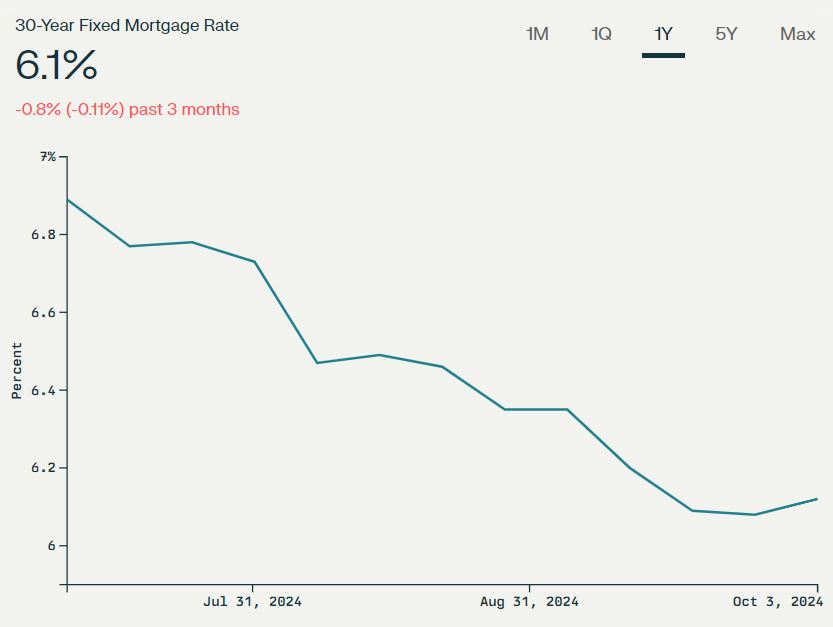Are today’s mortgage rates up or down? It’s a question on everyone’s mind and the answer, as you might expect, is not a simple yes or no.
Are mortgage rates rising again? Trends for October 4-5, 2024
Think of mortgage rates as a roller coaster. They are in constant motion, influenced by a lot of things. The most important player? The Federal Reserve (the Federal Reserve). The Federal Reserve controls interest rates, and they influence what lenders charge for mortgages. When the Federal Reserve lowers rates (as it did recently), generally It means lower mortgage rates for you and me. But it’s not that simple.


Another important factor? Investor confidence in the economy. If investors believe the economy is strong, they might buy more treasuries, which drives up the yield on those bonds. This, in turn, often raises mortgage rates. Conversely, if investors are worried, they could pull back, leading to lower mortgage rates. It’s a complex dance, but understanding the key players helps you navigate the market.
Current Mortgage Rate Summary (October 4, 2024)
According to data from Bankrate, as of October 4, 2024, mortgage rates showed a slight increase across the board compared to the previous week. Here’s the breakdown:
| Mortgage type | Today’s rate | Last week’s rate | Change |
|---|---|---|---|
| Fixed for 30 years | 6.23% | 6.22% | +0.01% |
| Fixed for 15 years | 5.48% | 5.38% | +0.10% |
| ARM 5/1 | 5.89% | 5.80% | +0.09% |
| Fixed jumbo for 30 years | 6.41% | 6.35% | +0.06% |
| 30-year fixed refinancing | 6.21% | 6.19% | +0.02% |
Note: These are average rates. Your actual rate will depend on your credit score, down payment, and the type of loan you choose.
What’s behind these recent rate hikes?
The slight increase in rates last week could be due to several things. While the Federal Reserve rates have recently been cut, the market is always reacting to new economic data and investor sentiment. Even a small change in the economy can cause repercussions in the mortgage market. Remember, the relationship between Federal Reserve decisions and mortgage rates is not direct. There is always a bit of lag and other factors at play.
The 30-year fixed mortgage: a deep dive
The 30-year fixed mortgage is the most popular option for many home buyers. It offers predictable monthly payments, which is reassuring. However, there is a trade-off. Let’s look at the pros and cons:
Advantages:
- Predictable Monthly Payments: Budgeting becomes easier.
- Lower monthly payments: Compared to shorter-term loans, your monthly payment is lower.
Cons:
- More interest paid over time: You will pay significantly more interest over the life of the loan.
- Slower principal growth: More of your prepayments go toward interest, leaving less to pay down the principal.
15-year fixed mortgage: a faster way
A 15-year fixed mortgage has higher monthly payments, but pays off much faster. This means you’ll pay significantly less interest overall and build equity faster. It’s a great option if you can manage the higher monthly payments.
Adjustable Rate Mortgages (ARMs): The Risky Option
ARMs have a fixed interest rate for a set period (such as five years for a 5/1 ARM), after which the rate adjusts periodically. While they may offer lower introductory rates, they carry more risk. If interest rates rise, your monthly payments could increase significantly.
Jumbo loans: for high-level purchases
Jumbo loans are for homes that exceed the conforming loan limit set by Fannie Mae and Freddie Mac. These loans typically have higher interest rates and stricter qualification requirements.
What to expect in the coming months:
Predicting mortgage rates is never an exact science. However, now that the Federal Reserve is cutting rates and inflation shows signs of slowing, we are likely to see lower mortgage rates in the coming months, but don’t expect a dramatic drop. A gradual decline is more likely. Watch economic indicators and Federal Reserve announcements for clues.
Should I wait or buy now?
This is the million dollar question! The decision depends on your personal circumstances. If you’re comfortable waiting for potentially lower rates, that’s an option. But if you need to buy now, don’t be paralyzed waiting for the “perfect” rate. Remember, fees are just one piece of the home buying puzzle. You’ll also need to consider home prices, your financial situation, and your personal comfort level with debt.
My personal opinion:
While we may see lower rates soon, it’s best to prepare for continued volatility. Don’t rely solely on forecasts. Talk to a mortgage professional; they can help you analyze your financial picture and suggest the best course of action for your situation. Your job is to stay up to date on market trends.
Tips for finding the best mortgage rate:
- Compare prices: Get quotes from multiple lenders.
- Improve your credit score: A higher credit score often qualifies you for better rates.
- Make a larger down payment: This can significantly reduce your rate.
The conclusion
Today’s mortgage rates saw a slight uptick compared to the previous week, but the overall trend is influenced by many things. While the Federal Reserve’s recent rate cuts suggest a possible downward trajectory for mortgage rates, they are not a guarantee. Best advice? Stay informed, compare prices and speak to a mortgage professional for personalized advice.


